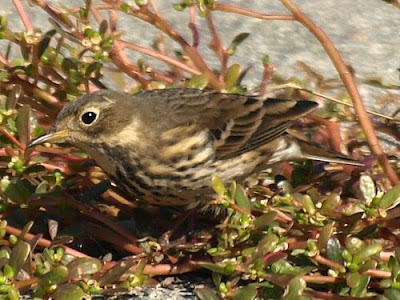22/10/10: An East 2 breeze veered to N1 and then calm. High clouds were present at dawn but soon cleared so it was hot over midday. Another early morning arrival of Thrushes was witnessed (including 50 Pale Thrushes that proved our maximum daily count of the species) and there were some high-flying flocks of White-Eyes. Finding an early morning White’s Thrush heralded another good day and a Lapland Bunting on the rocky headland behind the Dragon’s Pool was a reminder of the Beachy Head Autumn we had left behind. Whilst returning to the Minshuku for breakfast we saw a small Corvid arriving in off the sea over the harbour before disappearing over the pines heading towards the south of the isle. After breakfast we headed south west and found a juvenile Daurian Jackdaw had joined a Rook on the beach there and were sharing the beach with the Naumann’s Thrush that now proved far more obliging. We flushed a Pine Bunting from the School field and both the Siberian Buff-bellied Pipits and a Red-throated Pipit performed much better at Tsukasa. We met Asani-san at the Tower, where, whilst we watched a Radde’s Warbler that he had just found he picked out a Pallas’s Leaf Warbler that showed briefly to us amongst the Goldcrest flock there. Good numbers of migrants were seen down south in the late afternoon with a new Chestnut-eared Bunting, a male Siberian Rubythroat and a male Red-flanked Bluetail the best.


Spot-billed Duck and Mallard on the Dragon's Pool

Sparrowhawk over the Southwestern Enclosures


Daurian Jackdaw on the southwestern beach

Masked Bunting and spodocephala Black-faced Bunting in the southwestern enclosures


Masked Bunting at Tsukasa Fields


Dusky Thrush at Tsukasa Fields


Radde's Warbler near the Lighthouse

Bramblings along the western shore
Species noted:
Streaked Shearwater 150
Cormorant 2
Eastern Reef Egret 2
Great Egret 1
Grey Heron 3
Mandarin Duck 2
Teal 1
Mallard 1
Spot-billed Duck 1
Black-eared Kite 2
Sparrowhawk 3
Peregrine 1
Black-tailed Gull 50
Slaty-backed Gull 2
Rufous Turtle Dove 6
Great Spotted Woodpecker 1
Skylark 6
Olive-backed Pipit 3
Red-throated Pipit 1
Siberian Buff-bellied Pipit 15
Eastern Yellow Wagtail 1
Grey Wagtail 2
Amur Wagtail 1
Black-backed Wagtail 4
Brown-eared Bulbul 3
Siberian Rubythroat 1 male
Red-flanked Bluetail 1 male 3 female
Daurian Redstart 50
Blue Rock Thrush 2
White's Thrush 1
Pale Thrush 50
Dusky Thrush 60
Naumann's Thrush 1
Japanese Bush Warbler 20
Arctic Warbler 8
Pallas's Leaf Warbler 1
Radde's Warbler 1
Goldcrest 30
Japanese White-eye 80
Eastern Rook 10
Large-billed Crow 4
Daurian Jackdaw 1
White-cheeked Starling 3
Brambling 50
Oriental Greenfinch 10
Siskin 250
Mealy Redpoll 2
Japanese Grosbeak 2
Hawfinch 6
Black-faced Bunting spodocephala 2
Masked Bunting 6
Pine Bunting 1
Chestnut-eared Bunting 1
Elegant Bunting 30
Rustic Bunting 20
Reed Bunting 6
Lapland Bunting 1








































































